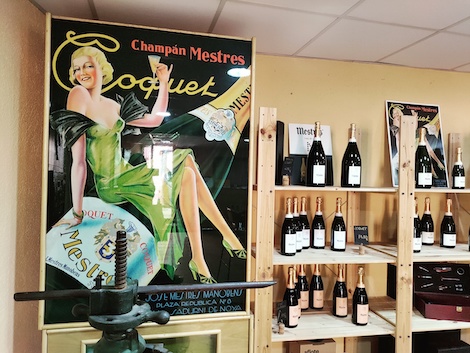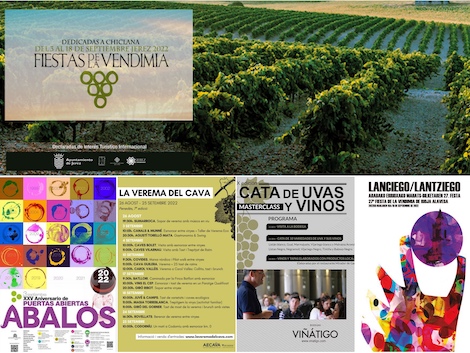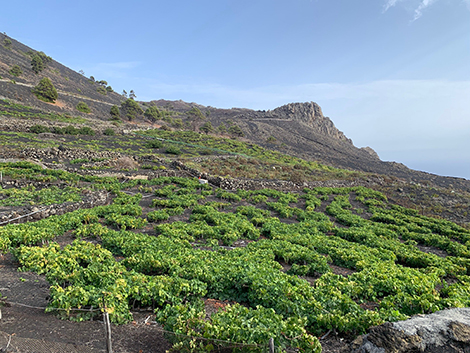Mestres: the long-ageing bodega that has always championed Cava

The Mestres bodega in the centre of Sant Sadurní d'Anoia has hardly changed since it was built almost a century ago. There is a great deal more wine resting in the underground cellar now than then, but the rattling of the bottles going up in the old lift probably doesn't sound much different from Christmas 1928, when Josep Mestres Manobens first bottled his "Mestres champagne" from the 1925 vintage. Until then the Mestres, who had been linked to Sant Sadurní d'Anoia since 1312, had grown vines and traded wine, but they had never had their own brand.
An engineer by trade, Josep Mestres continued to work in pursuit of new styles of wine until 1945, when he launched a sparkling wine without dosage, which he called Visol (in Catalan, "just wine"). Also known as Triple Seco, it was the first brut nature registered in the Spanish Patent and Trademark Office in 1948 and defined a style that still continues in the estate, now with the 29th generation at the helm: long-aged sparkling wines made using the traditional method.
Since the 1950s, Mestres was a strong advocate of the word Cava to identify his wines, to the point that all of the company's bottles had the word Cava printed on their labels from 1960 onwards, long before the birth of the DO Cava in 1976.
His son, Antonio Mestres Sagués, was not only one of the 14 co-founders of the Regulatory Board, but continued to vinify by variety, fermentation and ageing of the base wines with their lees in barrels, and especially in the presence of Cava wines in gastronomy, producing customized blends for restaurants.
"This was the game changer for Mestres," says Jaume Vial, commercial director of the Barcelona winery since 2017, while he shows us a framed picture with some of the bespoke labels that Antonio Mestres made for famous Catalan restaurants. "Thanks to the help and support of the late Santi Santamaría, chef at the famous Can Fabes, Antonio Mestres initiated the evolution of cava towards longer ageing times so that this sparkling wine could be enjoyed with an entire meal. His great contribution, at the time little understood, was to shift Cava from the dessert into the meal. It was also his great obsession.”

The Mestres brand was well positioned in Catalonia as a quality wine, but the search for a culinary role for its bubbles caused Antonio Mestres to pay a high price for swimming against the tide and being a pioneer at a time when the vast majority of cavas had sugar, were not aged and were served at celebrations and always with desserts. "Dedicating so much effort to research and experimenting implies successes but also some errors," Vial acknowledges. "When it came to ageing the wines, Antonio Mestres found that he had no control over oxidation; moreover, the brut nature wines of the 1980s were very dry on the finish and clients rejected them. It was a major cultural change.”
At the production level, Antonio Mestres was a visionary, but his management of the business suffered to such an extent that the winery had to file for bankruptcy and was on the verge of closure. Fortunately for the brand, on 12 May 1997, the day before the company was to be auctioned, two members of Antonio Mestres's in-law family bought the bodega, thus safeguarding its future.
From then on, Antonio Mestres stayed on at the winery until his retirement in 2005, but the efforts of the Aura Mestres, the new family at the helm, were focused on increasing turnover and creating multiple new wines in order to balance accounts.
After two decades of restructuring and having learned from past mistakes, the winery returned to its former traditions: long-aged wines with no added sugar, barrel fermentation, natural cork stoppers throughout the process, disgorging and manual remuage on riddling racks and classic wines with a vertical, dry finish and meant to be enjoyed with food. To achieve this, the number of wines was reduced from 25 to the current seven, reserva styles were no longer made and sales to supermarkets were stopped in order to focus on fine dining and specialist shops. "Fortunately, we found the support and help of the fine restaurants, which backed us,” confesses Vial. "Now we produce between 150,000 and 200,000 bottles, which is the ideal amount for the hectares we have.”
Ripe grapes and old vines
Old vines and the three traditional Cava varieties are two other important elements at Bodegas Mestres, whose latest project is to recover an abandoned vineyard planted in 1944. Of the 38 hectares they work —20 of their own and 18 with long-term leases— primarily in Sant Sadurní, Sant Llorenç d'Hortons and Sant Esteve Sesrovires, the youngest date from 1987 and lie at 225-250 metres elevation. The highest areas of this Catalan region, such as Pla de Manlleu and Pontons, where Parellada and Pinot Noir are planted at 700 m, are not their priority, as Mestres looks for ripe grapes, and in these high areas it is difficult to achieve the right degree of maturity. "We always pick the grapes by hand and some 15 to 20 days later than other growers," Vial explains. "We don't want acidity, but balance and freshness. That's why our Xarel.lo and Macabeo can be aged in barrels, unlike Parellada.”

The three varieties are planted in Viña Damiana, Mestres's flagship vineyard and the source of the winery's two top wines: Clos Damiana and Mas Vía. It is a hillside with two plots of five hectares in total planted in 1954 with a north-south orientation and good aeration from where the Montserrat crests are visible. In the past Mestres planted 33% of each variety, but nowadays Xarel.lo is the majority, although Macabeo is also grown in the lower, clayey part of the vineyard, as well as Parellada. The latter is planted in calcareous soils in the highest part, surrounded by the Mestres forest at the foot of the Cal Mestres mountain, evidence of the family's historical presence in these lands.
With yields ranging between 1,800-3,000 kg/Ha, it is not a productive vineyard, but the quality is very good, says Jaume Vial, who points out that thanks to its deep roots, the plants are capable of withstanding the dry climate. As in the rest of the vineyard, the vines are grown organically with cover crops. At present they are not certified, but Vial believes that they will be obliged to do so because some of their markets, especially the Nordic ones, and the DO Cava's strategic plan, will eventually demand such certification.
Changes in the bodega
The pandemic halted several planned investments in the facilities, but the fact is that ageing the wines for such long periods of time has created a space problem at Mestres. "This winery was designed to make 400,000 bottles, but to be sold every year or every two years maximum," explains Jaume Vial. "Now there are six-seven vintages in storage but we had as many as eight last year because of Covid.”
This lack of space has made it necessary to dismantle tanks and move them temporarily to the winery of a family friend, which is why they cannot be classified as an integral producer under the DO Cava regulations, but the idea is to refurbish or maybe even build a new winery in a couple of years outside the centre of Sant Sadurní, whose narrow streets are not the friendliest for the lorries that transport the wine.
Meanwhile, the in-house work at Mestres has to be meticulously organised so that the pieces of the puzzle fit together. In a winery where the bottles are periodically shaken to encourage the yeast autolysis process and achieve greater complexity, the problem of space is even more pressing. Jaume, one of the cellar workers, explains what this means: "There are 47,154 bottles on this wall; the first ones in have to be the first ones out, so we have to move them." Laying the bottles down must also be done carefully, in order to avoid any misalignments or breakages that could unbalance the wall and require the wall to be dismantled and rebuilt again.
"Sometimes we jokingly say that 20% of the work here is unproductive because we just move bottles from one place to another to generate spaces. It's more of a librarian's job, but everything here is handcrafted, bottle by bottle", explains Vial, who has over 20 years' experience in wine, and who works side by side with Joan Aura, owner and CEO, winemaker Moises Virgili and a dozen other workers.
One advantage of doing everything by hand is that small batches can be done, based on demand. At Mestres, three people do weekly disgorgements, always at room temperature. They take turns every 30-40 minutes to avoid saturating the nose after sniffing each bottle for cork taint. It is a slow process —each worker can disgorge about 900 bottles a day compared to 15,000 for a machine, but at Mestres, where everything is artisanal and there is little time for rushing, it makes perfect sense. After disgorgement, all the bottles rest in the cellar for two to five months, depending on whether the vintage is more or less acid, and are labelled when they are released with their date of disgorgement, total number of bottles in the vintage and individual bottle numbers.
Range of wines
In addition to meeting the two requirements that in Antonio Mestres's opinion were essential for a good cava —fine, integrated bubbles and a creamy finish— all Mestres wines are made with the three traditional varieties (with Parellada always in the minority) and undergo long ageing periods.
With the exception of Coquet, the entry-level cava that blends different vineyards and is sold with at least 42 months of ageing, the rest of the Mestres wines —four whites and two rosés— are aged in seasoned barrels, normally 225 litres, although they are now testing larger barrels. In the past, they were filled with still wine produced in-house, but now they use a third pressing of any of the estate's wines. These barrels go into use only after three years of bottling.
With the base wine aged for six months in barrels and a further 60 months in bottle, Visol still maintains the spirit of that first brut nature launched in 1945 and is a blend of the estate's own vines over 50 years old (60%) and the rest from rented vineyards over 25 years old. "It is made in the same way as Antonio Mestres, who always said that carbon dioxide should not be aggressive and should only be noticed in the centre of the palate, where the taste buds are, so that it can be enjoyed with food. In this wine, acidity, bubbles and oxidation are integrated, without any of them prevailing, which is why the finish is so balanced. It's the most versatile wine we make; it serves as an aperitif, but you can also pair it with food," Vial says.
In Clos Nostre Senyor, Mestres's first single-vineyard Cava, the percentage of Xarel.lo rises to 55%, but from the 2016 vintage (the current one on the market is 2012) the grapes will come from a different plot than the original one, located in Sant Sadurní, which had to be grubbed up due to disease. The new vineyard, where part of the grapes go to Visol, shares a similar profile, says Vial. "It is in Hortons and is a little higher, but it is also a valley with good aeration and similar soils to the original vineyard.” With the base wine aged for 10 months in chestnut barrels and over 90 months in bottle, the dry 2012 vintage maintains Mestres's trademark creaminess and volume on the palate with toasty and brioche notes but also freshness and vibrancy.

From the Viña Damiana vineyard come Clos Damiana and Mas Vía. The latter was the name of a now defunct farmhouse that once stood on the property. Depending on the vintage, the grapes go to one or the other wine, and if the year is very good in terms of quantity and quality, as was the case for the last time in 2004, both wines are made. With Mas Vía, which was launched first, the intention was to make a dessert wine, broader and with greater volume, compared to Clos Damiana, which is more vertical and versatile and made as Brut Nature, like the rest of the range. Both are released with about 12 years of bottle ageing, but according to Vial, Mas Vía gains in aromatic complexity compared to Clos Damiana, which is leaner. Choosing one or the other is probably a matter of taste; for those who prefer white wines with ageing and a mineral character, Clos Damiana will probably be their favourite; for those who enjoy round wines with structure on the palate or a cava to sip after dinner, Mas Vía will be more in line with that taste.
The range is completed with Rosat de Mestres, an entry-level rosé first released in 2022 with the 2018 vintage. It complements Elena, the house's classic rosé. Both are a blend of 20+-year-old Trepat, Monastrell and Garnacha and seek to be fresh in the first case, and a good food partner in the second.
Sales strategy and future outlook
According to Vial, Elena de Mestres ages very well and believes that the new rosé will follow suit, although, in keeping with the winery's philosophy, he is in no great hurry to expand into new markets. "65% of our wines are sold in Spain and the rest is exported. Our idea is to make a brand name first and go step by step, country by country. In Spain we are growing a great deal and haute cuisine has welcomed us very well,” assures Vial. "We are very careful with exclusivity; our wines are part of the pairings in some of the country's finest restaurants, but all with different vintages, sizes and wines. We try to provide a high standard of service to those we work with.”
The company's strategy is the same abroad, but Vial confesses that they are finding it harder because they concentrate on exclusivity, rather than quantity. However, he denies that the name Cava has had a negative effect on them. "Because of its history, character and personality, Mestres has always been recognised as Cava. In my opinion, what matters is the character of the house itself. We at Cava or Corpinnat would continue to do what we have always done. A great emphasis is placed on the importance of names, but ultimately there are those who do things very well and those who don't do so well. Let the consumer decide. One thing that is certain is that we are all part of the sector, and that is what we must take care of. From the vineyard to the consumer. It has to be a win-win situation for everyone.”
In keeping with remaining true to the character of the house, Joan Aura and Jaume Vial, both 63, are already shaping their vision of what Mestres should be in 20-30 years' time and what the 30th generation will inherit. Represented by the 27-year-old David Aura, Joan's son, he is already working at the winery and continuing his training in wine.
The idea is probably not to deviate too much from the path laid down by Antonio Mestres, who died in 2019 at the age of 77, and whose contribution to the world of sparkling wine is widely acknowledged in the sector, says Vial. "A few years ago, a local producer said to me: "Antonio Mestres saved us all a lot of money! Someone should pay tribute to this man who was not afraid to make mistakes and helped the rest of us to avoid those mistakes.”

Yolanda Ortiz de Arri
A journalist with over 25 years' experience in national and international media. WSET3, wine educator and translator
NEWSLETTER
Join our community of Spanish wine lovers






